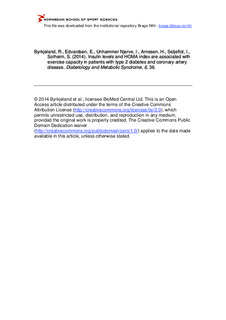| dc.description.abstract | Background: Previous studies on type 2 diabetes have shown an association between exercise capacity and insulin resistance. In patients with coronary artery disease (CAD) exercise capacity is often reduced due to exercise-induced ischemia. We have investigated the association between glucometabolic control, including the homeostatic model assessment (HOMA) of insulin resistance, and exercise capacity in patients with type 2 diabetes and CAD with and without exercise-induced ischemia.
Methods: In 137 patients (age 63.1 ± 7.9) cardiopulmonary exercise testing on treadmill was performed using a modified Balke protocol. The highest oxygen uptake (VO2peak) was reported as 30-s average. Fasting blood samples were drawn for determination of glucose, insulin and HbA1c. Insulin resistance (IR) was assessed by the HOMA2-IR computer model. Exercise-induced ischemia was defined as angina and/ or ST-depression in ECG ≥ 0.1 mV during the exercise test.
Results: HOMA2-IR was inversely correlated to VO2peak (r = -0.328, p < 0.001), still significant after adjusting for age, gender, smoking and BMI. Patients with HOMA2-IR above the median value (1.3) had an adjusted odds ratio of 3.26 (95 % CI 1.35 to 7.83, p = 0.008) for having VO2peak below median (23.8 mL/kg/min). Insulin levels were inversely correlated to VO2peak (r = -0.245, p = 0.010), also after adjusting for age and gender, but not after additional adjustment for BMI. The correlation between HOMA2-IR and VO2peak was also significant in the subgroups with (n = 51) and without exercise-induced ischemia (n = 86), being numerically stronger in the group with ischemia (r = -0.430, p = 0.003 and r = -0.276, p = 0.014, respectively). Fasting glucose and HbA1c were not correlated with VO2peak or AT.
Conclusions: Insulin resistance, as estimated by fasting insulin and the HOMA index, was inversely associated with exercise capacity in patients with type 2 diabetes and CAD, the association being more pronounced in the subgroup with exercise-induced ischemia. These results indicate that insulin resistance is related to exercise capacity in type 2 diabetic patients with CAD, possibly even more so in patients with exercise-induced ischemia compared to those without. | nb_NO |
